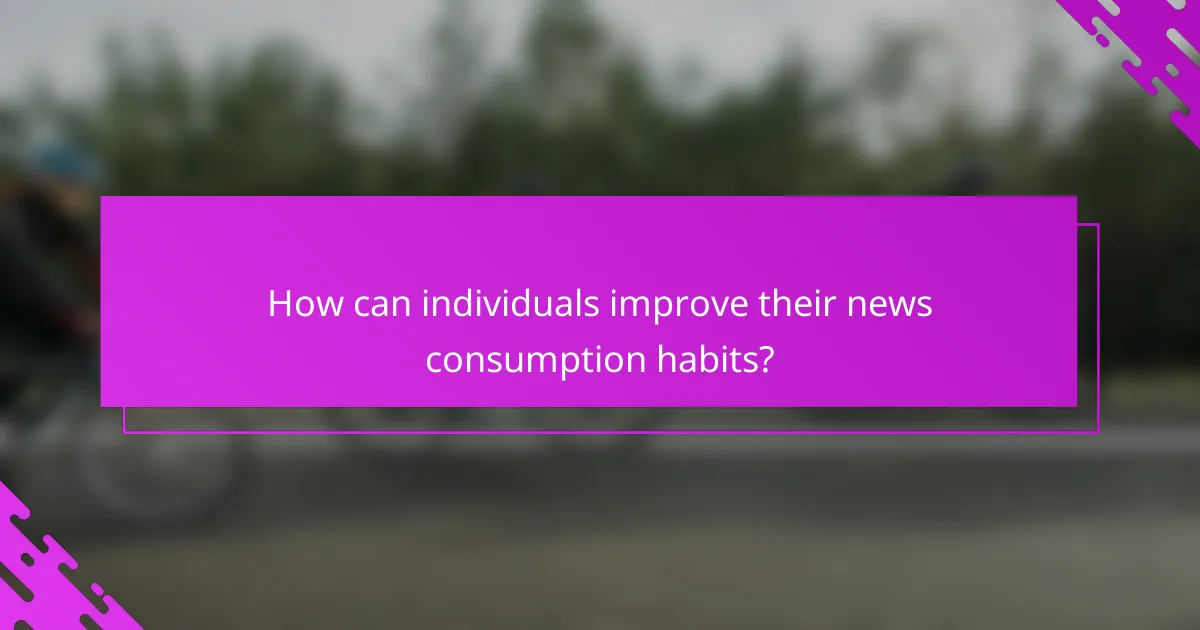Geographic variations play a crucial role in shaping perceptions of news trustworthiness, influenced by cultural, political, and regulatory contexts. As trust levels in media differ across regions, the consumption and interpretation of news are also affected. To evaluate news sources effectively, it is essential to implement methods such as systematic fact-checking and cross-referencing, which enhance reliability and credibility.

How do geographic variations affect news trustworthiness?
Geographic variations significantly influence perceptions of news trustworthiness, shaped by cultural, political, and regulatory factors. Different regions exhibit varying levels of trust in media sources, which can affect how news is consumed and interpreted.
Trust levels in North America
In North America, trust in news sources has been fluctuating, with many surveys indicating a decline in confidence, particularly among younger audiences. Factors such as political polarization and the rise of social media have contributed to skepticism towards traditional media outlets.
For instance, a significant portion of the population may view news through a partisan lens, leading to selective exposure to information that aligns with personal beliefs. This trend emphasizes the need for consumers to critically evaluate sources and seek diverse perspectives.
Trust levels in Europe
European countries display a mixed landscape of news trustworthiness, often influenced by historical contexts and regulatory frameworks. Northern European nations tend to report higher trust levels in media, attributed to strong public broadcasting systems and transparency standards.
Conversely, Southern and Eastern European countries may experience lower trust due to political interference and less robust journalistic practices. Consumers are encouraged to verify information through multiple sources and consider the credibility of the outlets they engage with.
Trust levels in Asia
In Asia, trust in news varies widely across countries, influenced by government control, media freedom, and cultural attitudes towards information. Nations like Japan and South Korea generally exhibit higher trust levels, supported by a competitive media landscape and high journalistic standards.
In contrast, countries with stringent government oversight, such as China, often see lower trust in media, as state-controlled narratives dominate public discourse. Individuals in these regions should be aware of potential biases and seek independent news sources when possible.

What evaluation methods enhance news trustworthiness?
Evaluation methods that enhance news trustworthiness include systematic fact-checking and rigorous peer review processes. These approaches help verify information accuracy and ensure that news content meets established standards for reliability.
Fact-checking organizations
Fact-checking organizations play a crucial role in verifying claims made in news articles. They assess the accuracy of statements by cross-referencing them with credible sources and data. Well-known organizations like Snopes and FactCheck.org provide transparency in their methodologies, allowing users to understand how conclusions are reached.
When evaluating news, consider checking claims against these organizations. They often categorize findings as true, false, or misleading, which can help readers quickly assess the reliability of information. However, be aware that not all fact-checkers cover every topic, so it’s wise to consult multiple sources for comprehensive verification.
Peer review processes
The peer review process is a standard in academic and scientific publishing that enhances the credibility of information. In this method, experts in the field evaluate research before publication, ensuring that the findings are sound and the methodology is robust. This process helps filter out unreliable studies and promotes high-quality content.
For news outlets, adopting a peer review-like approach can improve trustworthiness. This could involve having journalists collaborate with subject matter experts to validate information before dissemination. While this may slow down the news cycle, it significantly boosts the accuracy and reliability of reported information.

What are the best practices for assessing news sources?
To effectively assess news sources, it’s crucial to employ a combination of methods that enhance reliability and credibility. Key practices include cross-referencing multiple sources and analyzing the transparency of the sources themselves.
Cross-referencing multiple sources
Cross-referencing involves checking information against various news outlets to confirm accuracy. By comparing reports from different sources, you can identify discrepancies and gain a more comprehensive understanding of the story.
When cross-referencing, focus on reputable outlets known for journalistic integrity. Aim to consult at least three different sources, ideally from diverse perspectives, to ensure a balanced view. This practice helps mitigate bias and enhances the overall trustworthiness of the information.
Analyzing source transparency
Source transparency refers to how openly a news outlet shares its processes, funding, and editorial standards. Assessing this transparency can provide insights into potential biases and the reliability of the information presented.
Look for sources that clearly disclose their ownership, funding sources, and any affiliations that may influence their reporting. Outlets that provide information about their editorial guidelines and fact-checking processes tend to be more trustworthy. A good rule of thumb is to prioritize sources that are transparent about their operations and have a history of accountability.

How do cultural factors influence news perception?
Cultural factors significantly shape how news is perceived across different regions. Elements such as historical context, societal values, and local norms can affect trust levels in news sources and the interpretation of information.
Impact of local media landscape
The local media landscape plays a crucial role in shaping news perception. In countries with a diverse range of media outlets, audiences may have more options to cross-reference information, leading to higher trust levels. Conversely, in regions dominated by state-controlled media, skepticism towards news can be prevalent, as citizens may question the objectivity of the information presented.
For example, in Scandinavia, where press freedom is high, citizens generally exhibit greater trust in news sources compared to countries with restrictive media environments, such as North Korea. Understanding the local media context can help individuals assess the reliability of news they consume.
Role of social media in different regions
Social media’s influence on news perception varies widely by region, affecting how information is disseminated and consumed. In areas with high internet penetration, platforms like Facebook and Twitter can amplify news stories rapidly, but they can also spread misinformation quickly. This duality can lead to polarized views and distrust in traditional media.
In contrast, regions with limited access to social media may rely more on conventional news outlets, which can foster a different set of biases. For instance, in the United States, social media is a primary news source for many, often leading to echo chambers, while in parts of Africa, traditional radio remains the dominant medium, shaping news perception through localized content.

What tools can help evaluate news credibility?
Several tools can assist in evaluating news credibility, helping users discern reliable information from misinformation. These tools often analyze the sources, check facts, and assess potential biases in reporting.
Media Bias/Fact Check
Media Bias/Fact Check is a resource that evaluates the bias and factual accuracy of various news outlets. It categorizes sources based on their political leanings and provides a reliability rating, which can help users identify potential biases in the news they consume.
When using Media Bias/Fact Check, consider the source’s rating and its overall track record. For instance, a source rated as “left” or “right” may present information with a specific slant, which can influence how news is reported. Always cross-reference information from multiple sources to get a balanced view.
Snopes
Snopes is a well-known fact-checking website that investigates rumors, urban legends, and misinformation. It provides detailed analyses of claims, often breaking down the evidence and sources used to support or refute them.
To effectively use Snopes, search for specific claims or headlines to see if they have been evaluated. The site categorizes findings as true, false, or somewhere in between, which can guide users in determining the credibility of sensational news stories. Remember to check the publication date, as information can evolve over time.

How can individuals improve their news consumption habits?
Individuals can enhance their news consumption habits by actively seeking reliable sources and critically evaluating the information presented. This involves developing skills to discern credible news and engaging with a variety of perspectives to gain a well-rounded understanding of issues.
Developing critical thinking skills
Critical thinking is essential for evaluating news sources and content. Individuals should question the credibility of the information by considering the source’s reputation, checking for bias, and verifying facts through multiple outlets. A practical approach is to ask questions such as: Who wrote this? What evidence supports the claims? Are there any conflicts of interest?
To strengthen critical thinking, practice analyzing articles by summarizing their main points and identifying any logical fallacies. Engaging in discussions about news topics can also sharpen these skills, as it encourages the examination of different viewpoints and the rationale behind them.
Engaging with diverse viewpoints
Engaging with diverse viewpoints broadens understanding and helps individuals recognize biases in their own perspectives. This can be achieved by following news outlets that represent a range of political and social views, or by participating in forums that encourage open dialogue. Aim to read articles from both sides of an issue to appreciate the complexity of the topic.
Additionally, consider joining community groups or online platforms that promote discussions on current events. This not only exposes individuals to different opinions but also fosters critical thinking and empathy, which are vital for informed news consumption.
